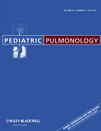Bronchoscopy in Cystic Fibrosis Infants Diagnosed by Newborn Screening
Abstract
Background
There is evidence of early functional and structural changes in babies with cystic fibrosis (CF) diagnosed on newborn screening (NBS). The aim of the present study was to determine the yield of bronchoalveolar lavage (BAL) microbiology and cytology, and 24 hr pH monitoring in a group of CF infants diagnosed on NBS.
Methods
Infants referred to a tertiary pediatric respiratory center between July 2007 and November 2009 underwent surveillance fiber-optic bronchoscopy (FOB), BAL, and insertion of a 24 hr dual pH probe under a single general anesthetic.
Results
We studied 33 infants, median age of 100 days (47–215 days) at the time of FOB. In 9 of 33 (27%) bacterial organisms were identified. Seven of the nine patients (78%) were asymptomatic and only one had had a positive cough swab prior to FOB. Neutrophilia was identified in 18/27 (67%) cases with a median of 11% (6–73%). 13/31 (42%) had an abnormal pH study with a pH index >12%.
Conclusions
The high yield of microbiology, cytology, and pH probe investigations in NBS infants justifies invasive surveillance. Longitudinal studies to determine if early aggressive treatment results in improved outcome are awaited. Pediatr. Pulmonol. 2011; 46:696–700. © 2011 Wiley-Liss, Inc.




